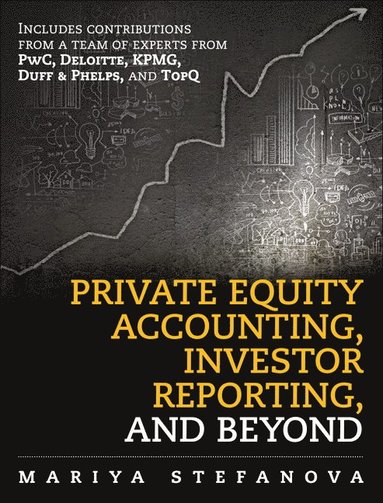
- Format
- Inbunden (Hardback)
- Språk
- Engelska
- Antal sidor
- 320
- Utgivningsdatum
- 2015-03-23
- Upplaga
- 1
- Förlag
- Financial Times/ Prentice Hall
- Illustrationer
- illustrations
- Dimensioner
- 241 x 190 x 25 mm
- Vikt
- Antal komponenter
- 1
- ISBN
- 9780133593112
- 657 g
Private Equity Accounting, Investor Reporting, and Beyond
Advanced Guide for Private Equity Managers, Institutional Investors, Investment Professionals, and Students
Slutsåld
Kundrecensioner
Övrig information
MARIYA STEFANOVA (London, UK), Partner at Private Equity Accounting Insights, has extensive experience in the specialist field of private equity accounting. As a senior trainer, she has trained over 150 fund accountants. Through her firm, she provides complete technical and training solutions for fund administrators and private equity houses, investor reporting services; carried interest design and modelling, and private equity accounting publications. Her professional experience spans roles at Augentius Fund Administration, Mourant International Finance Administration (now State Street), the French investment bank Calyon, and the private equity real estate manager Patron Capital Partners.
Innehållsförteckning
PART I: PRIVATE EQUITY ACCOUNTING, INVESTOR REPORTING, AND BEYOND 1
Chapter 1 Private Equity Structures and Their Impact on Private Equity Accounting and Reporting 3
Structuring Considerations in Private Equity 4
Main Building Blocks and Vehicles of a PE Structure 6
Domiciliation: Where to Form the FundOnshore or Offshore? 9
Simple or Complex? 9
Using a Combination of Vehicles 10
Master-Feeder Funds 11
Structures Involving Blockers 13
Parallel Structures 14
Master-Feeder or Parallel Structure? 15
Alternative Private Equity Structures 16
Summary 17
Chapter 2 The Importance of Allocations and Allocation Rules 19
Introduction: Why Start with Allocations and Allocation Rules? 20
What Is an Allocation Rule, and Why Is It So Important in Private Equity Accounting? 20
Types of Allocation Rules 21
Why Are Different Allocation Rules Used? Is Excel-Based Accounting Adequate? 22
How Do Inaccurate Allocations Affect Investors? 27
How Can You Identify the Allocation Rules in an LPA? 27
What Do You Do If the Allocation Rules Stipulated in the LPA Are Flawed? 28
What Is the Best Way of Doing Allocations? 29
A Word of Caution for LPs 30
Summary 30
Last Advice for LPs 30
Last Advice for GPs 31
Chapter 3 Private Equity Accounting Processes: Some Neglected Processes That Could Expose GPs 33
Introduction 34
Some Neglected Private Equity Accounting Processes 35
Rebalancing 35
Partner Transfers/Assignments 37
Summary 40
Chapter 4 Investor Reporting: ILPA versus IPEV IRG 41
Introduction 42
Existing Accounting Frameworks and GAAPs Used in Private Equity 43
What Is Investor Reporting? 44
Existing Reporting Framework 45
Comparisons among ILPA, IPEV, and EVCA Reporting Guidelines 45
Transition from EVCA RG and Other Local Reporting Guidelines to IPEV IRG 50
ILPA or IPEV IRG Compliant? 51
Summary 52
Endnotes 52
Chapter 5 ESG Reporting and Responsible Investing 53
Introduction 54
Why ESG and RI? 55
Potential Material Impacts of ESG Factors and Value Creation 56
What Are the Implementation Challenges? 57
Some ESG Issues 57
Sample Procedure for RI and ESG Implementation 58
Stage 1: Developing an RI Policy 59
Stage 2: Identifying Specific ESG Factors and Risks 59
Stage 3: Implementing ESG Objectives and Putting ESG Systems and Processes in Place 61
Stage 4: Assessing Existin...
Du kanske gillar
-
Peak Human
Johan Norberg
Inbunden -
Peak Human
Johan Norberg
Pocket -
Hayek's Bastards
Quinn Slobodian
Inbunden -
Atomic Habits
James Clear
Trade paperback (UK) -
Next Conversation
Jefferson Fisher
Trade paperback (UK) -
Trading Game
Gary Stevenson
Häftad
